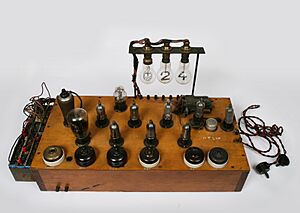C. E. Wynn-Williams facts for kids
Quick facts for kids
C. E. Wynn-Williams
|
|
|---|---|

Wynn-Williams at the Cavendish Laboratory in 1927
|
|
| Born |
Charles Eryl Wynn-Williams
5 March 1903 |
| Died | 30 August 1979 (aged 76) |
| Nationality | British |
| Education | Grove Park School, Wrexham |
| Alma mater | University College of North Wales and Trinity College, Cambridge |
| Spouse(s) | Annie Eiluned James |
| Children | Gareth and Tudor |
| Awards | Duddell Medal and Prize (1957) |
| Scientific career | |
| Fields | Physicist |
| Institutions | Imperial College, London, Telecommunications Research Establishment |
| Doctoral advisor | Ernest Rutherford |
Charles Eryl Wynn-Williams (1903–1979) was a Welsh physicist. He was known for his important work on electronic tools. These tools were used in the study of nuclear physics. His invention, the scale-of-two counter, helped a lot in the development of the modern computer.
Early Life and Education
Charles Eryl Wynn-Williams was born in Swansea, Wales, on March 5, 1903. His father was a physics teacher. Charles went to Grove Park School in Wrexham.
In 1920, he started studying at Bangor University. He graduated in 1923. He stayed at the university to do more research. He focused on electrical tools. In 1924, he earned his Master's degree. From his university days, he was known as C. E. Wynn-Williams.
Amazing Pre-War Discoveries
In 1925, Wynn-Williams went to Trinity College, Cambridge. He continued his research at the Cavendish Laboratory. He worked under the famous scientist Sir Ernest Rutherford. In 1929, he earned his PhD.
His most important work during this time was creating electronic tools. These tools were used in studying radioactivity and nuclear physics. Like many scientists then, he loved working with electronics.
In 1926, he built an amplifier. This device could make very small electrical currents much stronger. Scientists soon realized these amplifiers could help detect and count alpha particles. These particles were important in Rutherford's experiments. Rutherford encouraged Wynn-Williams to focus on building a reliable amplifier. He also wanted him to find ways to count these particles.
Wynn-Williams made many great contributions to nuclear physics. In 1929–30, he worked with H. M. Cave and F. A. B. Ward. They designed a special electronic counter. It used thyratrons, which are a type of electronic switch. By 1931, his amplifier and counting system were used regularly.
Wynn-Williams' amplifier was very important. It helped James Chadwick discover the neutron in 1932. It was also used in many other experiments.
In 1932, Wynn-Williams shared details of his new counter. It was called the "scale-of-two counter." This device allowed scientists to count particles much faster than before. His inventions became key tools in nuclear physics. They opened up new ways for research. Many laboratories in Europe and the USA copied his designs. Wynn-Williams often gave them advice.
In 1935, Wynn-Williams became a physics lecturer at Imperial College London. He kept working on electronic tools. He helped develop nuclear physics at Imperial College.
Wartime Contributions
When World War II was about to begin, Wynn-Williams joined many other scientists. He started working on RADAR, which stands for Radio Detection and Ranging. He worked at the Telecommunications Research Establishment.
During the war, the Allies faced a challenge. Nazi Germany started using a new, more complex Enigma machine. This machine had an extra rotor. This made it much harder to break their secret messages. The Bombe machines, designed by Alan Turing, took much longer to work. Faster Bombes were needed. Wynn-Williams helped develop these new, high-speed Bombes.
He worked with a team that created a special attachment for the Bombe. It had fast wheels and an electronic sensing unit. This attachment was called the Cobra Bombe. Even though it was not always reliable, it showed new ways to approach the problem.
Later in 1942, British intelligence started receiving more secret messages. These messages came from a German cipher machine called Tunny. This machine was used for very important messages between German commanders. A young scientist named W. T. Tutte figured out how these messages could be broken. He shared his idea with his boss, Max Newman. Newman realized that only a machine could do the job fast enough.
Newman knew about Wynn-Williams' work on electronic counters. He asked for his help. Wynn-Williams worked with a team, including Tommy Flowers. They built a machine to break the Tunny code. This machine was called Heath Robinson. The Robinson machines were early versions of the Colossus computers. The Colossus machines were the world's first programmable electronic computers.
After the War
After the war, Wynn-Williams returned to Imperial College. He focused on teaching physics to students. He was a very good and well-liked teacher. He became a reader in physics at Imperial. In 1957, he received the Duddell Medal and Prize. This award recognized his important work on the scale-of-two counter.
Like most people who worked at Bletchley Park, Wynn-Williams did not get official recognition for his wartime work for a long time. He always kept his work secret, as he had promised. However, he remained interested in codes and puzzles throughout his life.
Professor Reginald Victor Jones, a UK government science advisor during the war, wrote about Wynn-Williams in 1981. He said that the modern computer was only possible because of Wynn-Williams' invention. He called the scale-of-two counter "one of the most influential of all inventions."
In 1970, Wynn-Williams retired. He and his wife moved to Dôl-y-Bont in Wales.


